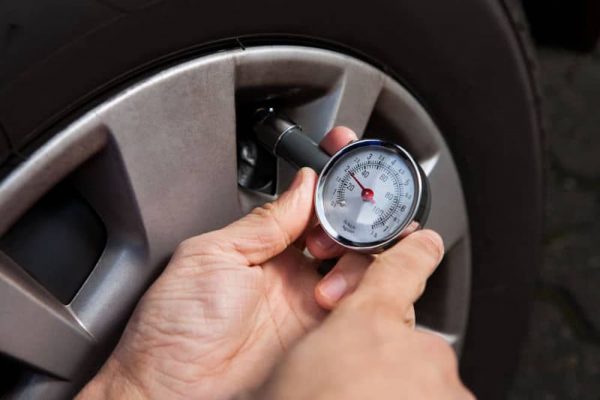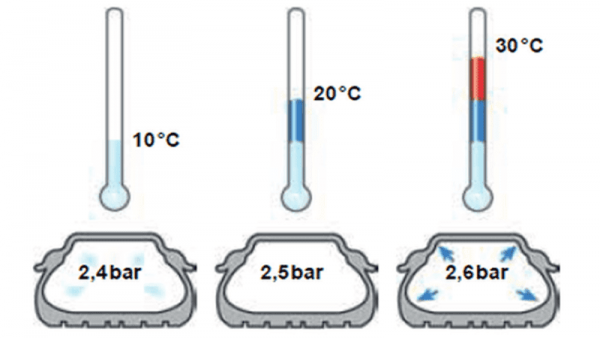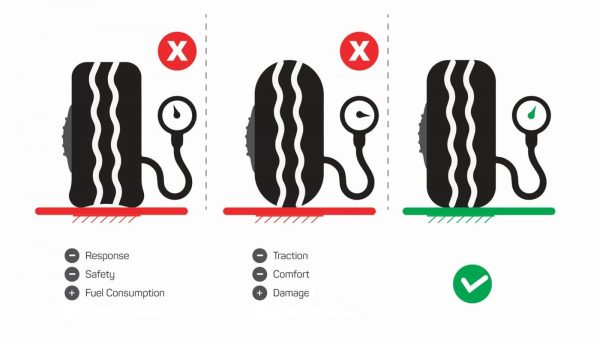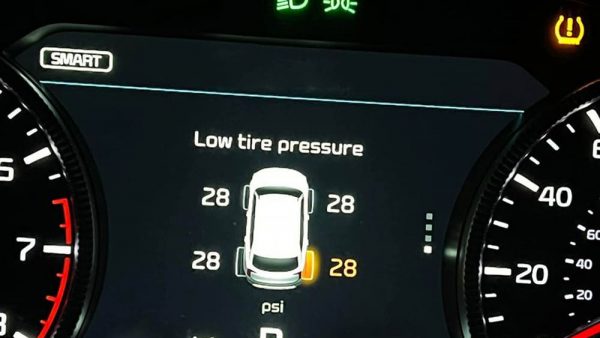Determining the appropriate tire pressure for your vehicle is more than just a routine check; it’s a crucial aspect of maintaining vehicle safety, performance, and efficiency. Typically, vehicle manufacturers provide the recommended tire pressures, and these are often displayed on a sticker located on the driver-side door jamb. This is the vertical pillar where the door connects and locks when closed. However, you might also find this information on the rear edge of the driver’s door, inside the glove compartment, or on the inner side of the fuel-filler door. As a fail-safe, the vehicle’s owner’s manual is another reliable source for this data.
While the process might seem straightforward, there are several nuanced considerations to ensure accurate tire pressure:
- Cold Inflation Pressure Importance: The term ‘cold inflation pressure’ refers to the optimal tire pressure when the tires are not influenced by external heat sources. For an accurate reading, the pressure check should ideally be conducted after the vehicle has been parked in a shaded area for several hours. Accuracy can be compromised by factors such as the vehicle being in a temperature-differentiated environment like a warm or cool garage, exposure of the tires to direct sunlight, or recent vehicle use (even a short drive of a few miles). Additional information on how temperature variances can affect tire pressure is detailed in a dedicated section.
- Diverse Pressure Requirements: It’s important to note that some vehicles may specify different inflation pressures for the front and rear tires, especially when carrying heavy loads. In these cases, a higher pressure is usually recommended for the rear tires.
- Spare Tire Pressure Checks: For those vehicles equipped with a spare tire (excluding models that come with just a sealing kit and a pump), regular pressure checks are vital. Spare tires, particularly the compact “doughnut” types that require higher pressures than standard tires, are prone to air loss over time. Accessing and checking these tires can be cumbersome, especially if they are located underneath the vehicle.
- Adjustments for Tire Size Changes: The pressure information provided is specific to the tire size originally fitted on the vehicle. If you have customized your vehicle with different-sized wheels and tires, the original recommended pressures might not be ideal. In such cases, consulting with a tire specialist to determine the correct pressure for the new tire size is advisable.
Additionally, it’s critical to distinguish between the pressure indicated on the tire’s sidewall and the manufacturer’s recommendation. The sidewall marking indicates the maximum safe inflation pressure, which is not necessarily the optimal pressure for your specific vehicle model. Adhering to the manufacturer’s recommended tire pressure is key to ensuring optimal tire performance, extended tire life, and enhanced safety on the road.
By taking these factors into account, you can effectively manage your vehicle’s tire pressures, thereby ensuring a smoother, safer driving experience and prolonging the lifespan of your tires. Remember, regular tire pressure checks are a small yet significant step in vehicle maintenance that can lead to significant benefits in terms of performance and safety.
Exploring the Dynamic Relationship Between Ambient Temperature and Automotive Tire Pressure
Delving into the intricate relationship between ambient temperature changes and their impact on automotive tire pressure reveals a complex yet critical aspect of vehicular safety and performance. The conventional wisdom holds that for every 10-degree Fahrenheit fluctuation in temperature, there’s an approximate shift of 1 psi (pound per square inch) in tire pressure. This relationship stems from the basic principles of thermodynamics, where air inside the tires expands with rising temperatures, thereby increasing the pressure, and contracts when temperatures drop, leading to decreased pressure. However, this generalization, though convenient for quick reference, does not apply uniformly across various tire types and models. In reality, the pressure variation can be more nuanced, approximately around 2% per 10-degree temperature change.
The implications of this phenomenon become particularly significant during seasonal transitions. For instance, tires that are last checked and inflated during a hot summer day are prone to under-inflation as the temperature plummets in the fall and winter months. The resultant pressure drop could be in the range of 7 to 10 psi from summer to winter. Such a drop in tire pressure can have far-reaching consequences, affecting vehicle handling – particularly in sudden, evasive maneuvers – increasing the odds of a tire failure, and causing uneven and accelerated tire wear.
Modern vehicles often come equipped with advanced tire pressure monitoring systems (TPMS). These systems are designed to alert the driver via a dashboard warning light, typically depicted as a stylized “U” with an exclamation mark, when tire pressure falls significantly – usually around 25% – below the manufacturer’s recommended level. The reverse can also occur: tires inflated to the correct pressure during the cold months may become overinflated as temperatures climb, necessitating a release of air to maintain optimal pressure. While a slight over-inflation is generally less hazardous than under-inflation, maintaining the recommended tire pressure is crucial for optimal vehicle performance and safety.
Additionally, the act of driving itself influences tire pressure. The friction generated between the tire and the road surface naturally heats up the tires, temporarily increasing their internal air pressure. Sun exposure can also contribute to this effect. Therefore, to achieve the most accurate tire pressure measurement, it is advised to check the pressure in the early morning or after the vehicle has been at rest for an extended period, ensuring the tires have cooled down to ambient temperature.
Furthermore, understanding these dynamics is essential for maintaining vehicle efficiency. Properly inflated tires ensure better fuel economy, reduce the carbon footprint of the vehicle, and enhance overall driving comfort. Regular tire pressure checks, therefore, are not just a safety measure but also a step towards environmentally conscious driving and cost efficiency.
In summary, the interplay between temperature and tire pressure is a nuanced aspect of vehicle maintenance. By staying informed and proactive in tire pressure management, drivers can ensure safer driving experiences, prolong tire life, and contribute to more sustainable vehicle operation.
Optimizing Vehicle Safety: A Comprehensive Guide to Tire Pressure Management
The Role of Tire Pressure Monitoring Systems in Modern Vehicles
In an era where technology enhances vehicle safety and performance, Tire Pressure Monitoring Systems (TPMS) stand out as a crucial component. Select modern vehicles are equipped with a TPMS that allows drivers to monitor tire pressures through an interactive screen. This feature not only provides real-time data but also adds a layer of convenience, particularly when compared to traditional tire pressure monitoring methods. However, many vehicles still lack this integrated technology, necessitating the use of manual methods for tire pressure monitoring, with the tire gauge being the primary tool.
Selecting the Ideal Tire Gauge: A Key to Accurate Tire Pressure
The market offers a variety of tire gauges, with the standard push-on gauge being the most common and economical choice. Despite its popularity, this traditional gauge often presents challenges in forming a secure seal on the tire valve, potentially leading to inaccurate readings and unintended air loss, which compromises tire pressure integrity. An effective solution is to opt for a screw-on tire gauge. These models, slightly more expensive in the range of $10 to $20, ensure a more reliable and airtight connection to the tire valve. They typically feature an enlarged, easily readable dial and a user-friendly push-in button for fine-tuning tire pressure, especially useful when adjustments are needed for overinflated tires.
The Importance of Regular Tire Pressure Checks
Adhering to a monthly tire pressure check schedule is a common recommendation, yet many drivers find this frequency challenging to maintain. Beyond these routine checks, it’s beneficial to incorporate visual inspections into one’s regular vehicle assessment. This involves comparing the appearance of the tire’s contact with the ground from the front to the rear on the same side, to detect any discrepancies in tire inflation. However, the effectiveness of visual checks can be limited with modern low-profile tires, where such differences are not as easily discernible.
Various factors can influence tire pressure, including but not limited to, temperature changes, natural air leakage, punctures from road debris like nails or screws, or damage from significant road impacts, such as encountering a pothole. These elements highlight the necessity of monitoring tire pressure more frequently than once a month, particularly in regions with fluctuating weather conditions or rough road surfaces.
Seasonal Adjustments for Optimal Tire Pressure
A strategic approach to tire pressure maintenance involves conducting thorough checks at least twice a year: during a warm period in late spring and a cooler period in late fall. This timing aligns with typical seasonal temperature shifts, which can markedly affect tire pressure. For example, on a day with temperatures around 32 degrees in late fall, anticipating colder weather ahead, it might be prudent to add a few extra pounds per square inch (psi) to the tires. Maintaining tire pressures slightly above the manufacturer’s recommendation usually does not cause significant issues but may result in a firmer driving experience. This proactive measure ensures the vehicle operates safely and efficiently throughout the year, adapting to various environmental conditions.
Conclusion
In wrapping up our comprehensive analysis on the topic of tire pressure, it becomes increasingly clear that this often-overlooked aspect of vehicle maintenance is, in fact, a cornerstone of automotive performance, safety, and environmental responsibility. This article has taken a deep dive into the multifaceted nature of tire pressure, underscoring its critical importance in a variety of contexts.
The connection between tire pressure and vehicular safety has been a major focus of our discussion. We’ve seen how improper tire inflation can lead to a host of hazards, including diminished handling capabilities and prolonged braking distances. Insufficient tire pressure compromises the structural integrity of the tire, increasing the likelihood of accidents. Conversely, over-inflated tires can lead to uneven wear and a decrease in traction, which can be just as perilous. By maintaining tires at their ideal pressure, these risks are significantly reduced, ensuring a safer driving experience.
Our exploration also delved into the realm of fuel economy. We learned that tires at their optimal pressure level require less energy to roll, thus enhancing fuel efficiency. This not only has immediate financial benefits for drivers, in terms of lower fuel costs, but it also plays a part in mitigating environmental impacts by reducing carbon emissions. The importance of this cannot be overstated in our current climate, where every step towards sustainability counts.
Another significant aspect we covered is the relationship between tire pressure and the longevity of the tires themselves. Proper inflation ensures more uniform wear, thereby extending the life of the tires. This is not only a matter of economic savings but also of environmental concern, as it reduces the frequency of tire disposal and the associated environmental burden.
Moreover, we discussed the effects of environmental factors, such as temperature fluctuations, on tire pressure. This highlighted the necessity of regular tire pressure checks and adjustments to counteract these natural variations. Such diligence ensures that the tires remain in their optimal state, irrespective of the weather or season.
In bringing this article to a close, the overarching message is clear: diligent attention to tire pressure is a small but significant step that yields far-reaching benefits. It transcends the immediate realm of automotive maintenance, touching on vital issues of safety, efficiency, and environmental stewardship. Vehicle owners are encouraged to embrace the habit of routinely monitoring and adjusting their tire pressure. This simple practice is a proactive stride towards safer roads, better vehicle performance, enhanced fuel economy, and a more sustainable future. Ultimately, tire pressure is more than just a number on a gauge – it’s a fundamental component of responsible vehicle ownership and operation.




